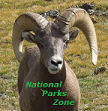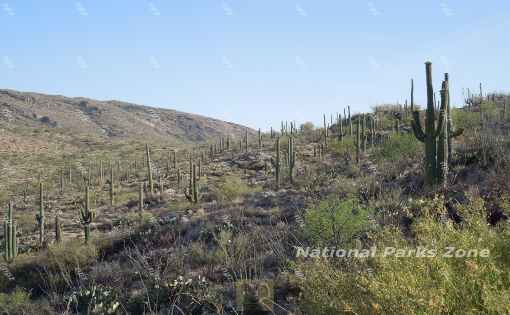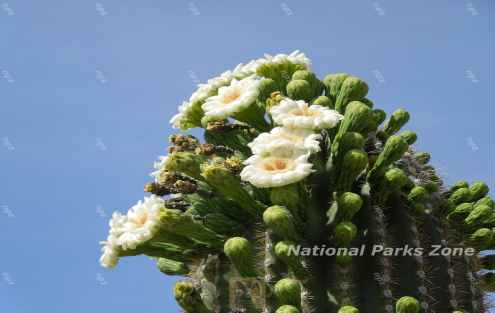Copyright © 2014-
All Rights Reserved

Updated 02/11/23 7:04 PM
Other Resources
Saguaro National Park on the National Parks Service website -
Saguaro National Park -
Saguaro National Park -
Arizona-
Old Tucson Studios -
Tombstone, Arizona -
Saguaro National Park
Arizona's Saguaro National Park is home to iconic giant saguaro cactus. These residents of the Sonoran Desert can grow to 60' and live for 200 years.
Arizona
2013
About The Park
Saguaro National Park is two parks sandwiched around Tucson, Arizona and is composed of the Rincon Mountain District to the East and the Tucson Mountain District to the West. Both parks are Sonoran Desert parks and, while to most visitors they look the same, they actually have different wildlife and plants. The iconic saguaro cactus, long a symbol of the west, is found in both.
Like so many national parks this started out as Saguaro National Monument in 1961 and became a national park in 1994. It’s another southwestern desert park and you can expect average temperatures between May and October to be above 90°F with June and July averaging over 100°F.
The huge saguaro cactus can live 200 years but they grow very slowly. A 15-
There are 24 other species of cactus found in the park including fishhook cactus, barrel cactus, prickly pear cactus, and the Jumping Cholla. This last one gets its name from the barbed spines that detach easily onto the clothes of passerby’s who thought they avoided it and only later found out how painful they are to remove when you get one stuck in your finger.
Rincon Mountain District
This is the western part of the park and is the larger part. Virtually all of it is backcountry and designated wilderness. There’s a nice one-
There are a number of short hikes off the road into the desert. At one point in the drive we saw about an 18 inch long Gila Monster crossing the road. This is a rare treat as they are not often seen according to the park rangers. I got out of the car to photograph him and I could see that he wasn’t thrilled with my presence so I quickly backed up to be that much further away from him. When your presence causes the creature to change its behavior then you are too close and need to give it space. All the more so with a venomous lizard. We watched him amble off into the underbrush and disappear. You can see his picture in the photo gallery.
The Tucson Mountain District
This is the western part of the park and the part that I found more interesting mainly because of the Golden Gate Road. This was a good graded road that you could take across the park and really get the feel of the desert. We passed by some huge saguaro cacti which, at the time I was there in mid-
If you have been to a Saguaro visitor center, I would recommend going north out of Tucson and taking Pictured Rocks Road to the Golden Gate Road into the loop road. You can double back and exit past the Red Hills visitor center to take the road back to Tucson. If you haven’t been to a visitor center then maybe you’d want to take this the other way so you can stop at the Red Hills visitor center for information about the park. Since the Golden Gate Road is graded, and less traveled, it would be best to inquire about the shape of the road before committing to it.
Wildlife
Mammals found in the park are javelinas, bobcats, foxes, cougars, coyotes, mule deer, white tailed deer, jack rabbits, ring-
Lodging
There is no lodging in the park. The city of Tucson, Arizona sits in the middle of both units of Saguaro National Park and you can find any kind of lodging you desire there.
Hiking
Keep in mind that hiking in the Saguaro National Park is desert hiking. You will need to carry lots of water. Don’t get too hung up on how much it weighs. As you drink it the load will lighten. That’s an incentive to drink which is exactly what you need to be doing. The temperature in the summer often can reach 100°F (38 C) and dehydration is an ever present danger. This National Park Service page for Hiking In Joshua Tree National Park is just as relevant in Saguaro.
Although we were there in May, the temperatures were in the 90’s and that was an impediment to taking our usual 3-
Valley View Overlook Trail
In the Tucson Mountain District this is an easy walk off the Bajada Loop Drive to a nice overlook of the Sonoran Desert.
Freeman Homestead Trail
This is an easy 1 mile out-
Desert Ecology Trail
This is an easy, informative little loop, in the Rincon Mountain District, that explains the local ecology.
Other Points of Interest
Arizona-Sonora Desert Museum
The museum sits and 98 acres and is a combination zoo, botanical gardens, art gallery, aquarium and natural history museum. You would be hard pressed to find a better way to learn about the Sonoran Desert. Most of the exhibits are outdoors so they can better to show things in as natural a setting as they can.
Old Tucson Studios
Located a few miles outside of the Tucson Mountain District this was an old studio which was used for filming many television westerns and movies. In the theme park mold there are the usual shootouts and stunt shows.
Tombstone, Arizona
Having grown up on the TV series Tombstone Territory and ‘the town too tough to die’, and having the time to drive the 70 miles from Tucson, I couldn’t resist visiting Tombstone. My thought was it was going to be a hokey wild west type theme park but I just had to see it. As it turned out there was some of that. We did see a reenactment of the legendary Gunfight at the O.K. Corral but all in all we had a very enjoyable day and saw lots of history. We had lunch at one of the saloons with the waitresses in period costumes and old west saloon decor.
The highlight of the day was wandering around Boot Hill with the graves of the cowboys, who lost the shootout with the Earp’s, and some of the humorous gravestone epitaphs. I thought that the wooden grave markers didn’t look old enough to be original and I had my doubts as to their authenticity. In my travels around the Internet I came across a picture of Gene Barry, who played Bat Masterson in the TV series, standing next to a wooden grave marker with the epitaph that I found most humorous. While the marker that I saw was not the original, the epitaph on the real marker was the same. It was probably removed to keep it safe or possibly was stolen by a thoughtless souvenir hunter. You can see a picture of it in the photo gallery.
Saguaro National Park Photo Gallery


Other National Parks and National Monuments Within a Day’s Drive
Petrified Forest National Park Only 271 miles and a 5 hour drive and you can see the painted desert and trees turned to stone from the age of the dinosaurs.
Grand Canyon National Park -
Joshua Tree National Park famous for its iconic Joshua Trees and boulder piles is 360 miles to the west and about a 5.5 hour drive.
Montezuma’s Castle National Mounument
A 20-
Sedona, Arizona World famous for its magnificent red rock cliffs and canyons this town is 250 miles north and about a 4 hour drive.
*N*P*Z*
National Parks Zone